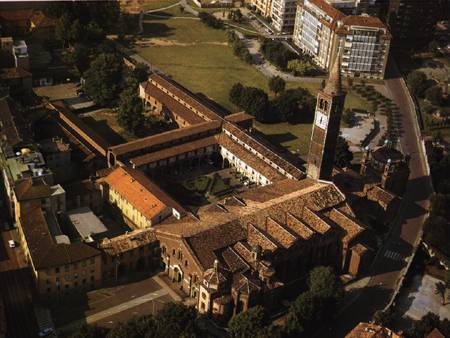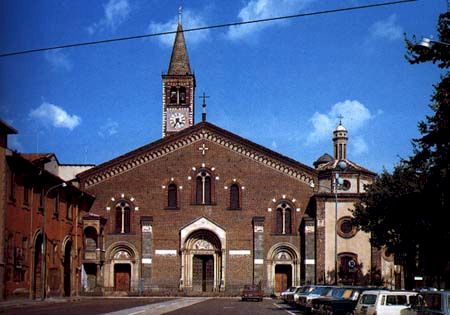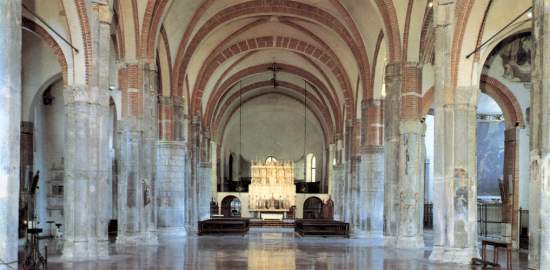 |
Home | Milan Through the Centuries | Tour's Map | Versione Italiana |
| Milan - Basilica of Sant'Eustorgio | ||||
The unassuming fašade of very important church is visible on this plesant little square.
Sant'Eustorgio was commissioned in 515 by Bishop Eustorgio II who had it built over
the site of even older 4th century building put up during the time of Bishop
 Eustorgio I. At the end of the 11th century the church was rebuilt until
Frederik Barbarossa caused its almost complete distruction in 1164; he even took
the Roman sarcophagus supposed to contain the relics of three Magi to Cologne. In 1190
recostruction, which would last several centuries, was undertaken: the family chapels on
the right side of the church clearly exibit the varius building stages. The 15th
century brought the southside chapels and a gem of Renaissance architecture, the Portinari
Chapel. The belltower whith its typical Lombard decoration of arches and cone-shaped
cups was built between 1297-1309.
Eustorgio I. At the end of the 11th century the church was rebuilt until
Frederik Barbarossa caused its almost complete distruction in 1164; he even took
the Roman sarcophagus supposed to contain the relics of three Magi to Cologne. In 1190
recostruction, which would last several centuries, was undertaken: the family chapels on
the right side of the church clearly exibit the varius building stages. The 15th
century brought the southside chapels and a gem of Renaissance architecture, the Portinari
Chapel. The belltower whith its typical Lombard decoration of arches and cone-shaped
cups was built between 1297-1309.The single aisle church whith 225 foot long nave conveys a
sense of vastness, increased by the optical illusion deriving from a slight inclination
of the massive piers going down the nave. The church contains so many art treasures it
might well be called a museum.
The Brivio Chapel, recently restored to its Renaissance
splendor, whith the tombs of Giacomo Stefano Brivio by the brother Francesco
and Tommaso Cazzaniga and Briosco and the Torelli Chapel whith the
Gothic arc on twisted columns used as Pietro Torelli's sepulchre, are two noteworthy
examples. The Visconti Chapel contains the tomb of Stefano Visconti, a gothic
masterpiece by Giovanni di Balduccio. The frescoes decorating the chapel bear Tuscan
 influence, namely thath of Giotto. The marble altar frontal whith scenes of Passion
of Christ, left unfinished, is a masterpiece, though it was warked on throughout many
periods by many great but anonymous sculturs amog which we may pick out International style,
(perhaps even Giovannino de' Grassi) Campionese, and Fiorentine master.
influence, namely thath of Giotto. The marble altar frontal whith scenes of Passion
of Christ, left unfinished, is a masterpiece, though it was warked on throughout many
periods by many great but anonymous sculturs amog which we may pick out International style,
(perhaps even Giovannino de' Grassi) Campionese, and Fiorentine master.Finally we come to the pure Rinassence Portinari Chapel
commissioned by the Florentine Pigello Portinari in 1462 and finished in 1468,
the year of his death. The chapel is a blend of the finest Tuscan architecture whith the
painting of Vincenzo Foppa, a new star in the late 15th century lombard
firmament. The frescoes high up on the walls, were discovered in 1878 and restored at the
beginning 20th century. They are truly Foppa's great masterpiece. At first the
architect was actually belived to be the Fiorentine Michelozzo, but today it is felt
that the church was designed by a Lombard master under Tuscan influence. The outside is
square shape whith four corner structures and surmonted by a dome enhanced by tondos. The
interior, also square, is decorated whith Foppa's stucco angels. In the center of the
chapel, stands the famous tomb of St. Peter Martyr, built by Giovanni di
 Balduccio, a follower of the great Pisan Innovator, Giovanni Pisano, between
1336 to 1339. Giovanni di Balduccio's work is a milestone in Lombard sculpture's march
towards the Renaissance, a harmoniuous blending of the classical Renaissance and sinous
vibrant Gothic line. The tomb, which in 1734 was moved from the left nave of the Basilica
to the Portinari Chapel, consists of the an elaborate white marble urn supported
by eight statues of Virtues resting on them. The bas-relief decorations on the urn descript
scenes from life of St. Peter Martyr. A tricuspidate niche above the lid of the
sarcophagus contains statues of the Virgin and child between Sts. Dominic and Peter Martyr,
statues of Christ givin His Blessing and two angels stand above the niche.
Balduccio, a follower of the great Pisan Innovator, Giovanni Pisano, between
1336 to 1339. Giovanni di Balduccio's work is a milestone in Lombard sculpture's march
towards the Renaissance, a harmoniuous blending of the classical Renaissance and sinous
vibrant Gothic line. The tomb, which in 1734 was moved from the left nave of the Basilica
to the Portinari Chapel, consists of the an elaborate white marble urn supported
by eight statues of Virtues resting on them. The bas-relief decorations on the urn descript
scenes from life of St. Peter Martyr. A tricuspidate niche above the lid of the
sarcophagus contains statues of the Virgin and child between Sts. Dominic and Peter Martyr,
statues of Christ givin His Blessing and two angels stand above the niche. |
| Sant'Eustorgio | Porta Ticinese | Loggia degli Osii | Mercanti Square - New Town Hall | Duomo | Royal Palace | Shopping |